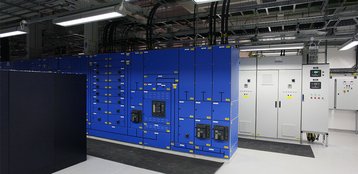In the UK, if you purchase new plant that is listed on the ETL (Energy Technology List) then the user can claim ECA (Enhanced Capital Allowance). Simply put, you get tax relief on your capital investment up front instead of spread over several years in a usual accounting methodology.
To be clear, you must be the end-user and you don’t get any ‘extra’ tax allowances, you just get it sooner. The scheme is intended to encourage the purchase of energy efficient plant but has its critics. For the OEM it is free to get listed as long as your product is in the top 20 percent of energy performance and you can use the logo to advertise your products. The biggest barrier to the scheme’s success is that most plant (e.g. large UPS systems) is not sold to the end-user but to a main contractor who is mainly interested in the price that the energy losses and the accounting trail that an end-user has to follow outweighs the benefit of the allowance.
A frustrating process
I have been involved (as a UPS OEM four times) with the ETL and found it easy to apply but, not least as a tax payer, frustrating in its rules and application.
The ETL includes 3-phase UPS as a technology that can attract tax rebates if the end-user purchases a product from the list. The scheme is based on work done by an independent consultant (in this case Riccardo at Harwell) and, as is usual in these cases, an organisation with no prior industry or specialist application knowledge of UPS.
In the UK (because we have a very low installed base of petrochemical, medical and machine-tool industries) we see more than 95 percent (of the power rating covered by the ETL) of all UPSs finding their way into data centres, although it is worth noting that we also have no indigenous UPS OEMs so only OEM sales offices, agents and resellers have an interest to get listed in the UK-only scheme.
A reduction in carbon footprint (through a reduction in losses) is the government’s target and the principle idea is that the ETL is meant to set a listing bar of 80 percent such that only the ‘best’ 20 percent (the highest efficiency) of products available are listed.
Anyone can get listed
This is the first point of failure of the scheme – the technology of transformer-less UPS with IGBT rectifier and IGBT inverter (which is now universally the norm in Europe) means that there is hardly any technical or cost barrier to any OEM finding themselves in the ‘bottom 80 percent’ and so ALL OEMs could, if they wish, get listed. The bottom line is that it is a no-brainer to design a double-conversion UPS with 96.5 percent efficiency or a line-interactive with 98 percent efficiency.
The UK, with its lack of UPS OEMs, has no Trade Association in place to lobby for the local suppliers. There ‘was’ one, a UK branch of CEMEP (the European Committee of Manufacturers of Electrical Machines and Power Electronics) run by Gambica (the trade association for instrumentation, control, automation and laboratory technology) - See more here, but it collapsed due to lack of membership, mainly a fees issue for the local sales offices. There was some effort in the last two to three years to reform the UK but it came to nothing. It also has to be said that CEMEP does not represent the rotary UPS industry, although it should as the ‘M’ in its name represents ‘machines’. This has left the ETL consultants with only the sales arms of the UPS OEMs to deal with, on what can be a complicated issue surrounded by sales fog.
Riccardo’s lack of experience also allowed a strange skew at the beginning of the scheme that continues to some extent even today: Under heavy representation from the rotary-UPS OEMs they split the listing into static and rotary lists. This was based on the proposal by the rotary UPS suppliers that their products were more expensive to purchase (true then and still true today) yet higher in efficiency (marginally true then, albeit not at the partial load that is endemic in enterprise data centres, but no longer true at any load).
This same ‘fairness’ (i.e. trying not to penalise a product or technology) continues today whereby ‘eco-mode’ static UPS have been effectively barred from the list by insisting that the only efficiency point that can be submitted is the ‘lowest in any operating mode’ and not the ‘highest’. So the ETL has deliberately stifled innovation for UK UPS users. There is a valid argument against ‘eco-mode’ being in the scheme (nearly all modern UPS have the eco-mode function built in as a standard feature but its enablement is optional by the end-user and so, if the end-user perceives that the risk of enablement is too great, they can simply choose not to enable the function) but they should have worked-up a qualification criterion rather than simply buckle under pressure from competing technologies.
Consider the efficiency limits:
Static-UPS, transformer-less, IGBT/IGBT, VFI (voltage and frequency independent) according to the IEC Standard
- Full-load efficiency 96.5 percent but with 25 percent load the efficiency is 93 percent (or, with a modular version of the same technology, 95 percent at 15 percent load)
- Enabling eco-mode produces >98.7 percent from 10-100 percent load
Rotary-UPS, none available as VFI, all VI (voltage independent) ‘line-interactive’
- Full-load efficiency 96.8 percent but with 25 percent load the efficiency is 88 percent (no modular versions available)
- No eco-mode available
Sales arguments
This is the second point of failure of the scheme – the purpose of the scheme is to reduce losses and so reduce emissions but it tries to differentiate products based on sales arguments, not technical facts.
There is one other failing in the scheme – an unnamed organisation (suspected to be a rotary UPS OEM) convinced the consultants that it was ‘most accurate’ to test UPS efficiency without the energy storage (battery in the case of most static and flywheel in the case of most rotary) system connected. As batteries require a miniscule amount of energy to remain fully charged but flywheels take ‘orders of 10’ greater to achieve the same state, the disconnection of energy storage is most advantageous to the rotary models’ efficiency. All data points are self-certified by the OEMs and the result are some really meaningless UPS efficiency data points (100 percent load, no flywheel losses) being listed in the ETL.
This is the third point of failure of the scheme – the ETL can be manipulated by OEMs capable of confusing the consultants by using out-dated preconceptions. There is not enough technical rigour to independently test concepts.
So, has the scheme been a success? No, because it has only offered tax-payer’s money via the treasury for NOT achieving the lowest energy losses possible, the reverse of what it should be doing. The fact that all OEMs could be listed makes a nonsense out of the ‘top 20 percent’ concept.
Has the scheme been widely used for UPS? It does not appear to have been. This is exacerbated by the fact that all UPS for new-build facilities are purchased through contractors who are more interested in lowest price than if the UPS is listed on the ETL for a tax-break that will not affect them.



